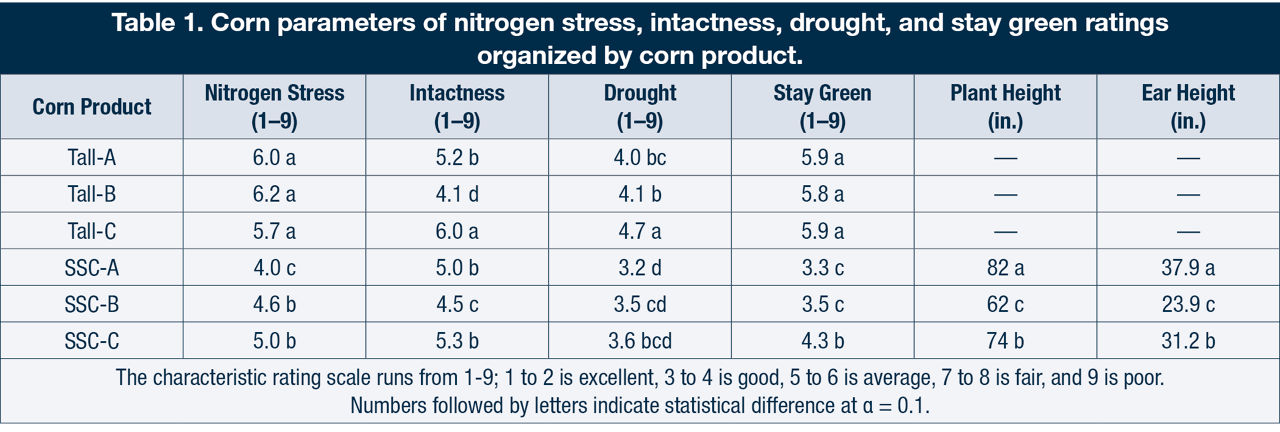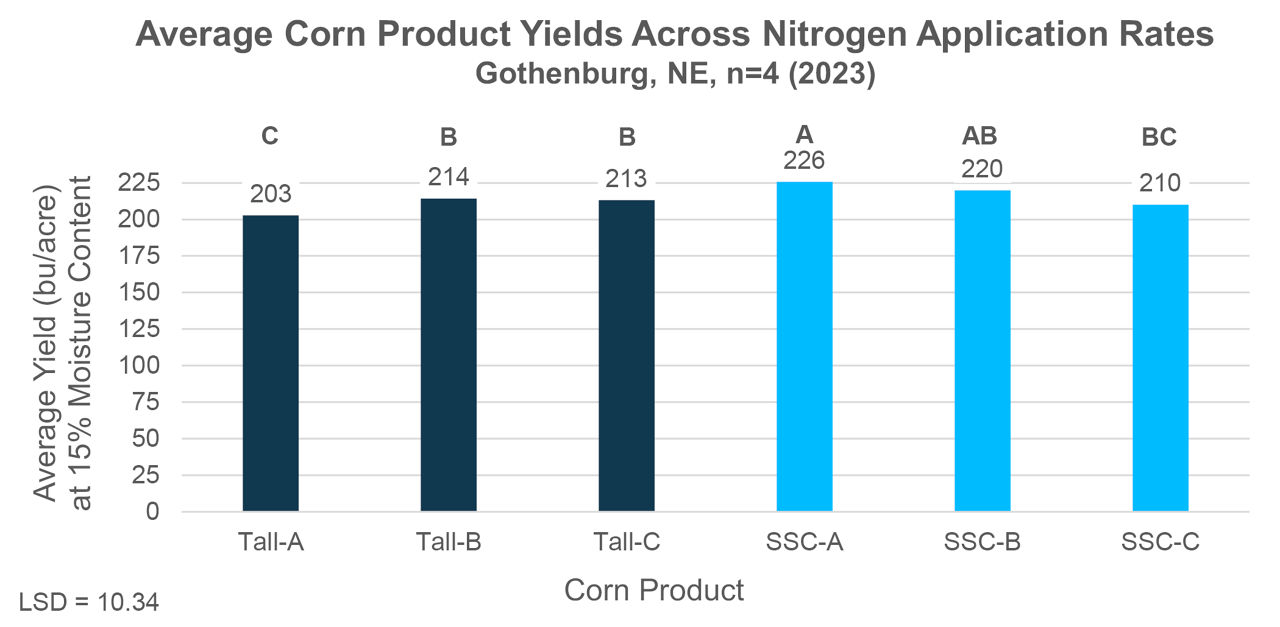5 MIN READ
Tall and Short Stature Corn Agronomic Response to Nitrogen Rates
June 19, 2024
Click on a tab below to see data collected each year for this study
TRIAL OBJECTIVE
- The optimum nitrogen (N) rate for corn can be difficult to determine, as different products can require different amounts of N. Inadequate N can cause a noticeable reduction in yield, whereas excess N can cause weak stalks and water quality risks.
- Short stature corn (SSC) is a new corn breeding innovation that will be part of the Preceon™ Smart Corn System set to launch in the United States within the next few years. SSC is intended to provide high-yielding corn with a shortened internode (the area between leaves), resulting in shortened corn height. Short stature corn will typically have a maximum height of seven feet and corn ear placement of at least two feet above the soil level.
- The reduced height of SSC is expected to decrease green snap and stalk lodging issues.
- The objective of this trial was to evaluate the effects of N rate on three commercially available corn products and three short stature corn (SSC) products.
RESEARCH SITE DETAILS
| Location | Gothenburg, NE |
| Soil Type | Hord silt loam |
| Previous Crop |
Corn |
| Tillage Type |
Strip-till |
| Planting Date | 05/03/2023 |
| Harvest Date | 10/19/2023 |
| Potential Yield (bu/acre) |
250 |
| Seeding Rate (seeds/acre) |
36,000 |
- The trial design was a split-plot with N fertilizer as the whole plot and corn product as the subplot, with four replications.
- A total of six N rates and six corn products were selected for this trial.
- N rates: 0, 60, 120, 180, 240, and 300 lb/acre
- Three tall corn products of 113 relative maturity (Tall-A, Tall-B, and Tall-C), and three short stature corn products of 110 to 113 relative maturity (SSC-A, SSC-B, and SSC-C) were evaluated.
- The nitrogen fertilizer used was 32-0-0 and was applied using the 360 Y-DROP® fertilizer tube attachments on 06/14/2023.
- Weeds were uniformly controlled with herbicides and no other pesticides were applied.
- Plant heights were measured at the R4 to R5 growth stage.
- Ear height, plant lodging, nitrogen stress, intactness, drought, and stay green ratings were collected close to harvest time.
- Plots were combine-harvested and total plot weight, test weight, and moisture measurements were collected.
- The grain yield was corrected to a standard moisture content of 15%.
UNDERSTANDING THE RESULTS


- Lower nitrogen rates (0 to 120 lb/acre) resulted in reduced lodging for products Tall-A and Tall-B (Figure 2A).
- Lodging increased with higher nitrogen rates (180 to 300 lb N/acre), though the 180 lb/acre N treatment was not statistically different from 60 or 120 lb/acre in product Tall-C (Figure 2A).
- Nitrogen treatments had less of an effect on lodging in product Tall-B than they did on the other tall products, though the 300 lb/acre nitrogen rate still produced a significantly higher percentage of lodged plants in Tall-B (19%) than the 0 lb/acre nitrogen rate (1%) (Figure 2A).

- In SSC products, no statistical difference was found between treatments regardless of nitrogen rate or product (Figure 2B).
- Lodging in all short corn products (Figure 2B) across all nitrogen rates (0 to 300 lb/acre) was not statistically different from all tall products (Figure 2A) within the 0 to 120 lb N/acre range.
- The 300 lb/acre nitrogen treatment did not produce significant differences in lodging between the Tall-B product (Figure 2A), the SSC-A product, and SSC-C product (Figure 2B).

- Tall products showed greater nitrogen stress compared to short stature products (Table 1).
- In general, tall products showed greater drought stress compared to short stature products, except SSC-C which showed similar drought stress to Tall-A and Tall-B (Table 1).
- Short stature products had greater stay green than tall products (Table 1).
- There was a strong correlation between plant height and ear height (R2 = 0.99) for short stature corn products. SSC-A produced the largest average ear height (37.9 inches), followed by SSC-C (31.2 inches), and SSC-B produced the smallest average ear height (23.9 inches) (Table 1).

- Higher nitrogen rates (180 to 300 lb/acre) produced poorer intactness and stay green. In addition, high nitrogen rates (240 to 300 lb/acre) increased drought stress (Table 2). The findings on the effects of nitrogen application rates on nitrogen stress, drought, and stay green can be justified by the hot and dry conditions found especially from August 10 to September 3 in Gothenburg, NE in 2023. Less nitrogen likely produced smaller plants, which required less water than larger plants to stay green and so experienced less drought stress.

- The average yield produced by short stature corn products (218.6 bu/acre) was numerically higher than that produced by tall corn products (210.1 bu/acre), but no statistical difference was found in this comparison (Figure 3).
- Short stature product SSC-A had the highest yield, though it was not statistically different from SSC-B (Figure 3).
- Two tall (Tall-B and Tall-C) and 2 short (SSC-B and SSC-C) products produced statistically similar average yields (Figure 3).
- The Tall-A product had the lowest overall average yield, though it was not statistically different from SSC-C (Figure 3).

- The 60 lb N/acre rate had the numerically highest yield but it was not statistically different from the 120 lb N/acre rate (Figure 4).
- Higher N rates (180, 240, and 300 lb/acre) had an intermediate effect on yield and were not statistically different from one another (Figure 4).
- The 0 lb N/acre rate had the lowest yield. It produced an average of 28.4 bu/acre less than the highest-yielding nitrogen rate (60 lb/acre) and 7.7 bu/acre less than the second lowest-yielding nitrogen rate 240 lb/acre), but it was not statistically different from the 240 lb N/acre rate (Figure 4).
KEY LEARNINGS
- Short stature corn was less prone to lodging when compared to tall corn regardless of the nitrogen rate used. In addition, short stature corn showed less N stress, had greater stay-green scores, and had the potential to show less drought stress than some tall corn products.
- Short stature corn could be a great alternative for farmers located in regions with a high risk of plant lodging and environments that may respond to increments in N application.
- Higher nitrogen rates do not always show a corresponding yield increase and certain parameters such as corn product characteristics, population, precipitation, soil type, crop rotation, and management practices should be considered when applying fertilizer.
- Carefully matching nitrogen rate with corn product, yield potential, soil moisture conditions, and residual soil nitrogen is key to maximizing the potential benefit of N fertilizer while minimizing potential drawbacks.
1213_220043
Seed Brands & Traits
Crop Protection
Disclaimer
Always read and follow pesticide label directions, insect resistance management requirements (where applicable), and grain marketing and all other stewardship practices.
©2024 Bayer Group. All rights reserved.